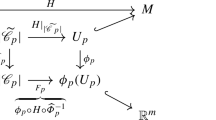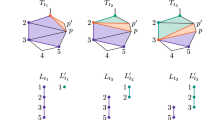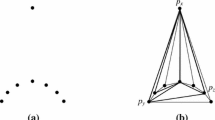Abstract
This paper introduces theoretical measures of efficiency for triangulations used in computing fixed points. The measures, for both regular triangulations ofR n and those with continuous refinement of grid size, are based on an average count of the number of simplices met by straight line segments. The computation of these measures is facilitated by a description of the facets as well as the vertices of a triangulation. We give a simple description of a modification of Eaves' and Saigal's K3 and compute the measures of efficiency of three regular triangulations ofR n and two triangulations of (0, 1] ×R n with continuous refinement of grid size, including the modified K3.
Similar content being viewed by others
References
A.R. Colville, “A comparative study of nonlinear programming codes”, Tech. Rept. No. 320-2949, IBM New York Scientific Center, New York (1968).
R. Courant,Differential and integral calculus, Vol. II (Interscience, New York).
B.C. Eaves, “Computing Kakutani fixed points”,SIAM Journal on Applied Mathematics 21 (2) (1971) 236–244.
B.C. Eaves, “Homotopies for computation of fixed points”,Mathematical Programming 3 (1972) 1–22.
B.C. Eaves and R. Saigal, “Homotopies for computation of fixed points on unbounded regions”,Mathematical Programming 3 (1972) 225–237.
H.W. Kuhn, “Some combinatorial lemmas in topology”,IBM Journal of Research and Development 4 (1960) 508–524.
H.W. Kuhn, “Computing roots of complex polynomials by pivoting methods”, Conference on Computing fixed points with applications, Clemson University, June 1974.
H.W. Kuhn and J.G. MacKinnon, “The sandwich method for computing fixed points”, VIII International Symposium on Mathematical Programming, Stanford University, August 1973.
P.S. Mara, “Triangulations of a cube”, M.S. Thesis, Colorado State University, Fort Collins, Color. (1972).
O.H. Merrill, “Applications and extensions of an algorithm that computes fixed points of certain upper semi-continuous point to set mappings”, Ph.D. Dissertation, University of Michigan, East Lansing, Mich. (1972).
R. Saigal, D. Solow and L. Wolsey, “A comparative study of two algorithms that compute fixed points in unbounded regions”, VIII International Symposium on Mathematical Programming, Stanford University, August 1973.
R. Saigal, “Investigations into the efficiency of fixed point algorithms”, Conference on Computing fixed points with applications, Clemson University, June 1974.
H. Scarf, “The Approximation of Fixed Points of a Continuous Mapping”,SIAM Journal on Applied Mathematics 15 (1967) 1328–1343.
M.J. Todd, “Union jack triangulations”, Conference on Computing Fixed Points with Applications, Clemson University, June 1974.
R.J. Wilmuth, Private communication.
L.A. Wolsey, “Convergence, simplicial paths and acceleration methods for simplical approximation algorithms for finding a zero of a system of nonlinear equations”, CORE Discussion Paper No. 7427, University of Louvain, Heverlee, Belgium (December 1974).
Author information
Authors and Affiliations
Additional information
This research was supported by National Science Foundation Grant GK-42092.
Rights and permissions
About this article
Cite this article
Todd, M.J. On triangulations for computing fixed points. Mathematical Programming 10, 322–346 (1976). https://doi.org/10.1007/BF01580679
Received:
Revised:
Published:
Issue Date:
DOI: https://doi.org/10.1007/BF01580679




